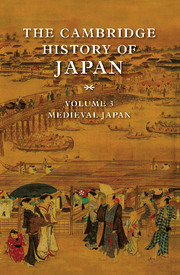Book contents
- Frontmatter
- Introduction
- 1 The Kamakura bakufu
- 2 Medieval shōen
- 3 The decline of the Kamakura bakufu
- 4 The Muromachi bakufu
- 5 Muromachi local government: shugo and kokujin
- 6 The decline of the shōen system
- 7 The medieval peasant
- 8 The growth of commerce in medieval Japan
- 9 Japan and East Asia
- 10 CULTURAL LIFE IN MEDIEVAL JAPAN
- 11 The other side of culture in medieval Japan
- 12 Buddhism in the Kamakura period
- 13 Zen and the gozan
- Works cited
- Glossary
- Index
- References
9 - Japan and East Asia
Published online by Cambridge University Press: 28 March 2008
- Frontmatter
- Introduction
- 1 The Kamakura bakufu
- 2 Medieval shōen
- 3 The decline of the Kamakura bakufu
- 4 The Muromachi bakufu
- 5 Muromachi local government: shugo and kokujin
- 6 The decline of the shōen system
- 7 The medieval peasant
- 8 The growth of commerce in medieval Japan
- 9 Japan and East Asia
- 10 CULTURAL LIFE IN MEDIEVAL JAPAN
- 11 The other side of culture in medieval Japan
- 12 Buddhism in the Kamakura period
- 13 Zen and the gozan
- Works cited
- Glossary
- Index
- References
Summary
In this chapter I shall describe and analyze Japan's relations during the Kamakura and Muromachi periods with various countries of East Asia and their governments, including the Sung, Yüan, and Ming dynasties of China, the Koryŏ and Yi dynasties of Korea, and the Ryūkyū Islands. My descriptions and analyses focus primarily on Japan's international political relations, particularly Japan's relationship with its Asian neighbors, the effect of this relationship on Japan's internal political developments, and, conversely, the influence of Japan's internal politics on its international relations. Because my research interests lie mainly in the Kamakura period, I shall discuss developments of that period more extensively than those of the later Muromachi period.
JAPAN'S INTERNATIONAL RELATIONS IN EAST ASIA
Around the tenth century the motive force in East Asia shifted from the Han People of China to the northern nomadic tribes, often called the conquest dynasties. In the thirteenth and fourteenth centuries, East Asian history centered on the rise and fall of the Mongol Empire. The Southern Sung (1127–1279) was reestablished after China's territory was reduced by the consecutive invasions of the Liao and Chin, which generated a financial crisis owing to the massive military expenses. The Southern Sung, whose resources and level of productivity were lower than those of northern China, inherited the developments that took place in various industries during and following the dominance of the Northern Sung (960–1127) and vigorously promoted foreign trade in hopes of resolving its financial crisis.
- Type
- Chapter
- Information
- The Cambridge History of Japan , pp. 396 - 446Publisher: Cambridge University PressPrint publication year: 1990
References
- 4
- Cited by



